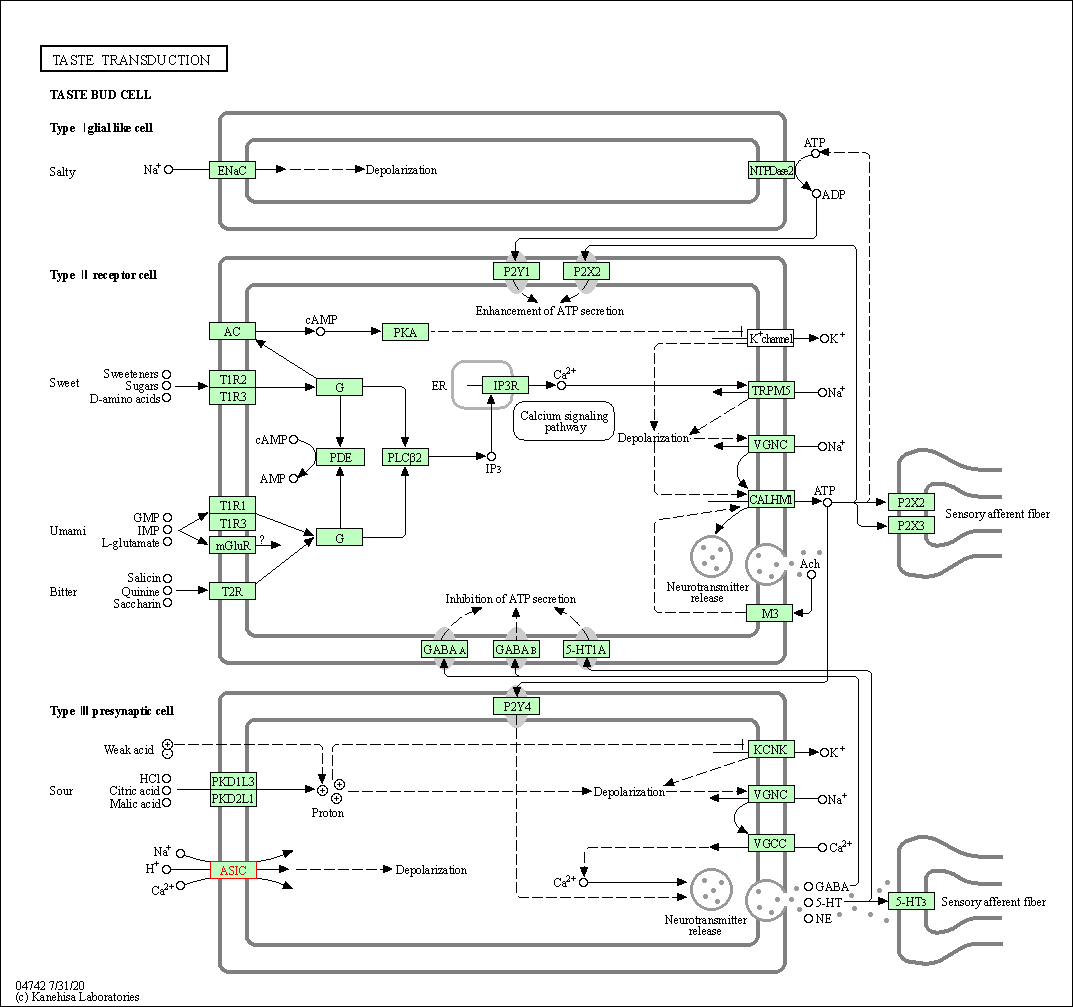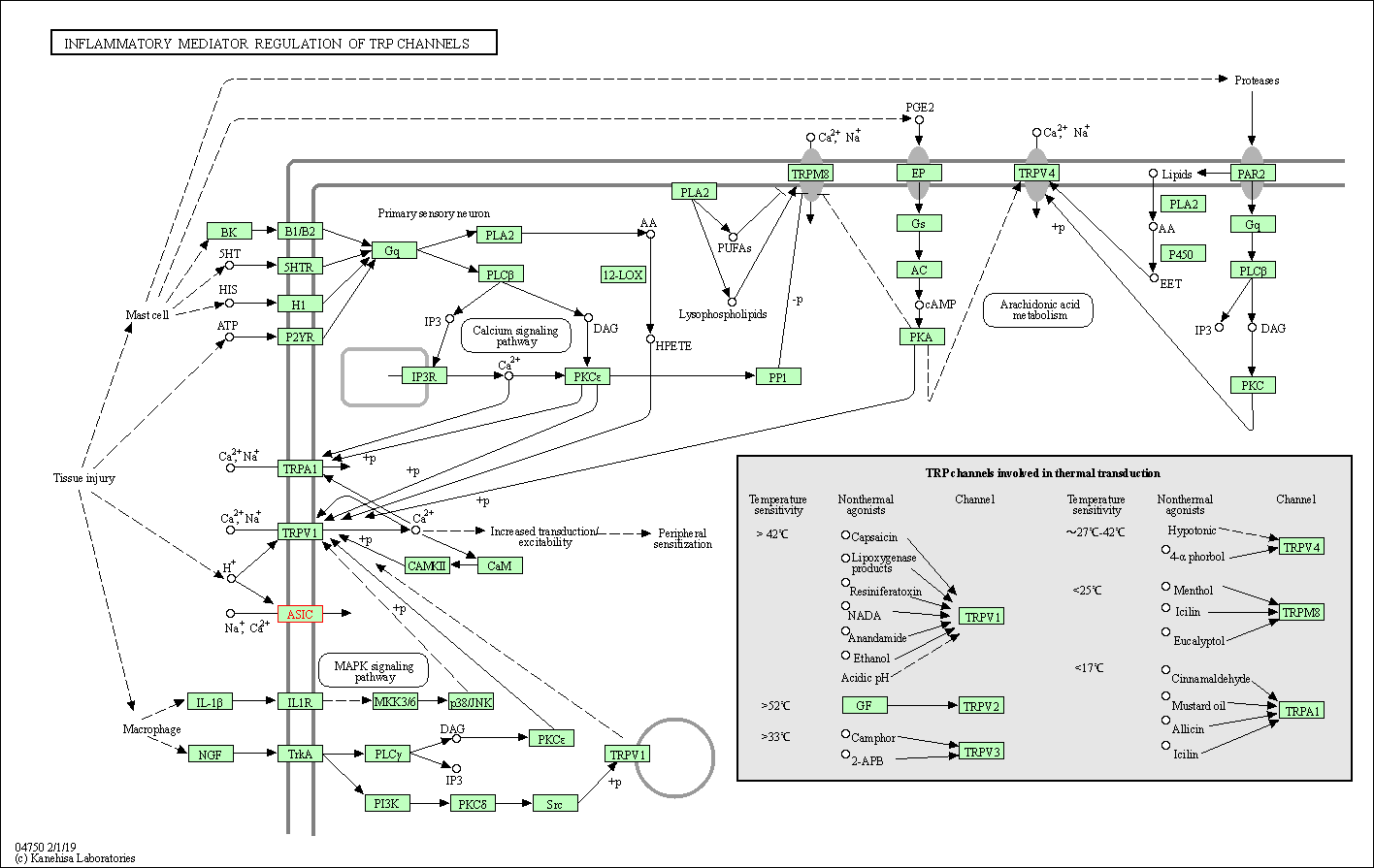Target Information
| Target General Information | Top | |||||
|---|---|---|---|---|---|---|
| Target ID |
T86541
(Former ID: TTDI02591)
|
|||||
| Target Name |
Acid-sensing ion channel 2 (ASIC2)
|
|||||
| Synonyms |
Mammalian degenerin homolog; Brain sodium channel 1; BNaC1; BNC1; Amiloridesensitive cation channelneuronal 1; Amiloridesensitive cation channel1, neuronal; Amiloridesensitive brain sodium channel; Acidsensing ion channel 2; ASIC2
Click to Show/Hide
|
|||||
| Gene Name |
ASIC2
|
|||||
| Target Type |
Literature-reported target
|
[1] | ||||
| Disease | [+] 1 Target-related Diseases | + | ||||
| 1 | General pain disorder [ICD-11: 8E43] | |||||
| Function |
Cation channel with high affinityfor sodium, which is gated by extracellular protons and inhibited by the diuretic amiloride. Also permeable for Li(+) and K(+). Generates a biphasic current with a fast inactivating and a slow sustained phase. Heteromeric channel assembly seems to modulate.
Click to Show/Hide
|
|||||
| BioChemical Class |
Amiloride-sensitive sodium channel
|
|||||
| UniProt ID | ||||||
| Sequence |
MDLKESPSEGSLQPSSIQIFANTSTLHGIRHIFVYGPLTIRRVLWAVAFVGSLGLLLVES
SERVSYYFSYQHVTKVDEVVAQSLVFPAVTLCNLNGFRFSRLTTNDLYHAGELLALLDVN LQIPDPHLADPSVLEALRQKANFKHYKPKQFSMLEFLHRVGHDLKDMMLYCKFKGQECGH QDFTTVFTKYGKCYMFNSGEDGKPLLTTVKGGTGNGLEIMLDIQQDEYLPIWGETEETTF EAGVKVQIHSQSEPPFIQELGFGVAPGFQTFVATQEQRLTYLPPPWGECRSSEMGLDFFP VYSITACRIDCETRYIVENCNCRMVHMPGDAPFCTPEQHKECAEPALGLLAEKDSNYCLC RTPCNLTRYNKELSMVKIPSKTSAKYLEKKFNKSEKYISENILVLDIFFEALNYETIEQK KAYEVAALLGDIGGQMGLFIGASILTILELFDYIYELIKEKLLDLLGKEEDEGSHDENVS TCDTMPNHSETISHTVNVPLQTTLGTLEEIAC Click to Show/Hide
|
|||||
| 3D Structure | Click to Show 3D Structure of This Target | PDB | ||||
| Cell-based Target Expression Variations | Top | |||||
|---|---|---|---|---|---|---|
| Cell-based Target Expression Variations | ||||||
| Different Human System Profiles of Target | Top |
|---|---|
|
Human Similarity Proteins
of target is determined by comparing the sequence similarity of all human proteins with the target based on BLAST. The similarity proteins for a target are defined as the proteins with E-value < 0.005 and outside the protein families of the target.
A target that has fewer human similarity proteins outside its family is commonly regarded to possess a greater capacity to avoid undesired interactions and thus increase the possibility of finding successful drugs
(Brief Bioinform, 21: 649-662, 2020).
Human Pathway Affiliation
of target is determined by the life-essential pathways provided on KEGG database. The target-affiliated pathways were defined based on the following two criteria (a) the pathways of the studied target should be life-essential for both healthy individuals and patients, and (b) the studied target should occupy an upstream position in the pathways and therefore had the ability to regulate biological function.
Targets involved in a fewer pathways have greater likelihood to be successfully developed, while those associated with more human pathways increase the chance of undesirable interferences with other human processes
(Pharmacol Rev, 58: 259-279, 2006).
Human Similarity Proteins
Human Pathway Affiliation
|
|
|
There is no similarity protein (E value < 0.005) for this target
|
| KEGG Pathway | Pathway ID | Affiliated Target | Pathway Map |
|---|---|---|---|
| Taste transduction | hsa04742 | Affiliated Target |

|
| Class: Organismal Systems => Sensory system | Pathway Hierarchy | ||
| Inflammatory mediator regulation of TRP channels | hsa04750 | Affiliated Target |

|
| Class: Organismal Systems => Sensory system | Pathway Hierarchy | ||
| Target Affiliated Biological Pathways | Top | |||||
|---|---|---|---|---|---|---|
| KEGG Pathway | [+] 2 KEGG Pathways | + | ||||
| 1 | Taste transduction | |||||
| 2 | Inflammatory mediator regulation of TRP channels | |||||
| Reactome | [+] 1 Reactome Pathways | + | ||||
| 1 | Stimuli-sensing channels | |||||
| WikiPathways | [+] 1 WikiPathways | + | ||||
| 1 | Iron uptake and transport | |||||
| References | Top | |||||
|---|---|---|---|---|---|---|
| REF 1 | URL: http://www.guidetopharmacology.org Nucleic Acids Res. 2015 Oct 12. pii: gkv1037. The IUPHAR/BPS Guide to PHARMACOLOGY in 2016: towards curated quantitative interactions between 1300 protein targets and 6000 ligands. (Target id: 685). | |||||
If You Find Any Error in Data or Bug in Web Service, Please Kindly Report It to Dr. Zhou and Dr. Zhang.

